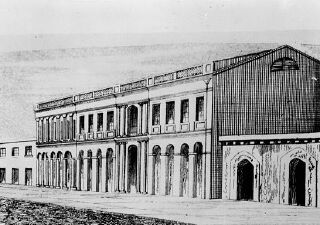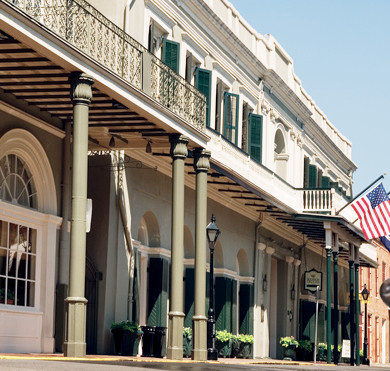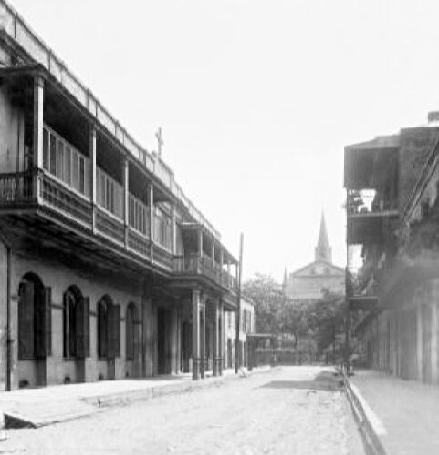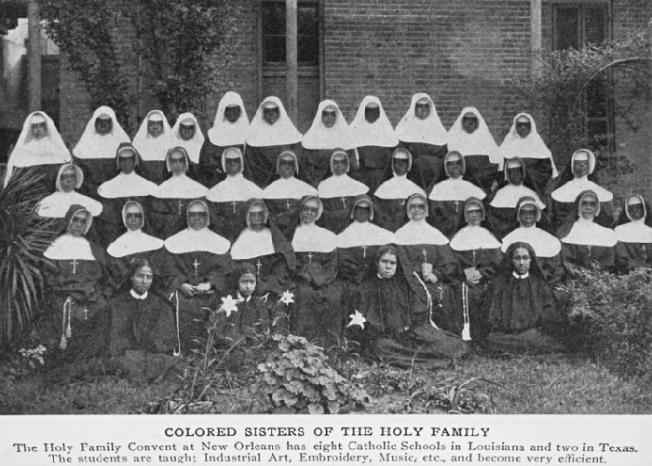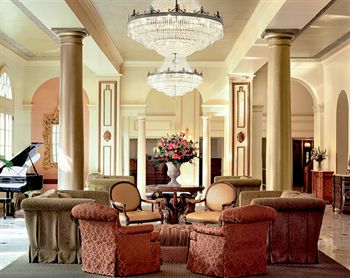| The Life of a Building: 1817 - 2011 Ballroom - Convent - School - Hotel |
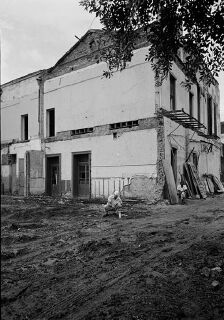
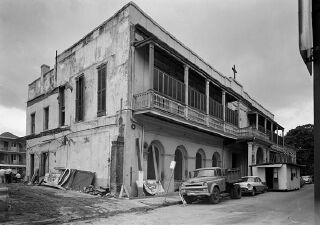
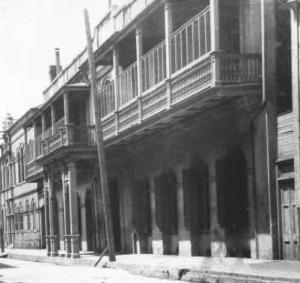
| Above, the building on Orleans Street, much as it looked when it was home to the famous Quadroon Balls. The photo at the top is of the building as it appears today, now the Bourbon Orleans Hotel. The wooden balcony that can be seen in the picture was just off the ballroom where the Quadroon Balls were held. It's said that on quiet moonlit nights, the ghosts of a young woman and her suitor can be seen standing at the balcony's railing. In fact, the Bourbon Orleans has a reputation among locals as New Orleans' most haunted hotel. |
| The Orleans Ballroom |
In 1817, an entrepreneur by the name of John Davis decided to build a luxurious ballroom. He
called it the Orleans Ballroom and its success prompted him to construct a building adjacent to it,
the Orleans Theatre. Here, he established French Opera in America. He continued to build
opulent dining and gaming rooms that equaled the best in Europe.
The Orleans Ballroom became famous for hosting the Quadroon Balls. At these balls, free women
of color, whose racial make-up was one quarter African-American, attended the ball, chaperoned
by their mothers, and were introduced to wealthy French suitors. Once the suitor had chosen one
of the young women, if her mother approved of the arrangement, he would buy her a house and
agree to support her for life.
This custom was known as "placage" and was unique to New Orleans. The sons of these unions,
which the men maintained in addition to their legal marriages with French women, were often sent
to France to be educated. The Quadroons and the children born of the first generation of placage
considered themselves to be Creoles of Color, they had French names, spoke the French
language and carried on French customs, as did their children after them.
The Quadroons have been the story of many novels about New Orleans, but very little written
history exists regarding the names and lives of the women - with a few exceptions, such as
Madame John, of Madame John's Legacy.
Later on, the building became a convent and school for the Sisters of the Holy Family, a religious
order founded in the city - the first female-led African-American religious order in the country. The
old ballroom became their chapel. Once, when a sister was showing a visitor the convent, she
stopped at the chapel door. "This is the old Orleans Ballroom; they say it is the best dancing floor
in the world. It is made of three thicknesses of cypress. That is the balcony where the ladies and
gentlemen used to promenade. Down there, on the banquette, the beaux used to fight duels."
called it the Orleans Ballroom and its success prompted him to construct a building adjacent to it,
the Orleans Theatre. Here, he established French Opera in America. He continued to build
opulent dining and gaming rooms that equaled the best in Europe.
The Orleans Ballroom became famous for hosting the Quadroon Balls. At these balls, free women
of color, whose racial make-up was one quarter African-American, attended the ball, chaperoned
by their mothers, and were introduced to wealthy French suitors. Once the suitor had chosen one
of the young women, if her mother approved of the arrangement, he would buy her a house and
agree to support her for life.
This custom was known as "placage" and was unique to New Orleans. The sons of these unions,
which the men maintained in addition to their legal marriages with French women, were often sent
to France to be educated. The Quadroons and the children born of the first generation of placage
considered themselves to be Creoles of Color, they had French names, spoke the French
language and carried on French customs, as did their children after them.
The Quadroons have been the story of many novels about New Orleans, but very little written
history exists regarding the names and lives of the women - with a few exceptions, such as
Madame John, of Madame John's Legacy.
Later on, the building became a convent and school for the Sisters of the Holy Family, a religious
order founded in the city - the first female-led African-American religious order in the country. The
old ballroom became their chapel. Once, when a sister was showing a visitor the convent, she
stopped at the chapel door. "This is the old Orleans Ballroom; they say it is the best dancing floor
in the world. It is made of three thicknesses of cypress. That is the balcony where the ladies and
gentlemen used to promenade. Down there, on the banquette, the beaux used to fight duels."
| On the left, the convent, with former promenading balcony above, dueling banquette below, bet.1910-20. |
| Sisters of the Holy Family Convent - St. Mary's Academy |
| Above, Sisters of the Holy Family, gathered on the patio of the convent on Orleans Street, abt. 1905; from a book published in 1917. |
The Sisters of the Holy Family Order was established in 1842, in New Orleans, by four
women. The order is now the oldest female-led African-American order in America. Their
first convent was a small building on Bayou Street, but they eventually moved to the building
that had once housed the Orleans Ballroom.
In 1926, Grace King wrote in New Orleans: The Place and the People: "It was in 1842 that the
Sisters of the Holy Family was founded. In the beginning, three young women of color,
descendants of three of the oldest and most respectable free colored families in the city,
came together to devote their lives, education and wealth to the cause of religion and
charity among their own people; to succor the helpless and old, to befriend friendless young
women, to teach the catechism to the young and to prepare young and old for sacrament of
communion. They were soon joined by another young woman, like themselves, of good
family, education and means. Their vocation, under the circumstances, seems sublime; their
name, a divine inspiration.
"Of their history and personality, beyond their having possessed the beauty of their class,
little is known. They concealed their past, with their features, under the veil or their order.
But, they, of their race, found the road to social equality. No white woman could do more;
none have done better. In no other place in the city does the future appear so
providentially directed as in this institution.
"They had many obstacles, trials and tribulations, but their perseverance never faltered. In
1881, they saw the promise of a new era dawning upon them. The old Orleans Ballroom was
for sale and they bought it. Not long afterward, the adjoining Orleans Theatre burned and
the sisters acquired the land and constructed an orphan asylum and a public chapel.
"When it is asked in the community, "Which are the sisters to whom one listens, and to
whom one contributes with the most pleasure?" the answer is unhesitating, "The little
colored sisters."
She continues, "It was on New Year's day, 1888, that the news spread through the community
that the Mother Superior of the Colored Convent of the Holy Family was dead. It was an
occasion for the friends and well-wishes of the convent to pay the respect of a call; for
those of the Catholic faith to do more. The body had not yet been transported to the chapel.
She laid on the cot on which she had died a few hours before. Can one ever forget the
sight? All around the bed were kneeling figures from the street, from the market; there
were servants, beggars, sisters, orphans and ladies of the community; people of all races."
In the 1960's, a need for expansion caused the order to sell the property on Orleans Street
and move to New Orleans East, where they remain, still dedicated to the community they've
served for so long.
women. The order is now the oldest female-led African-American order in America. Their
first convent was a small building on Bayou Street, but they eventually moved to the building
that had once housed the Orleans Ballroom.
In 1926, Grace King wrote in New Orleans: The Place and the People: "It was in 1842 that the
Sisters of the Holy Family was founded. In the beginning, three young women of color,
descendants of three of the oldest and most respectable free colored families in the city,
came together to devote their lives, education and wealth to the cause of religion and
charity among their own people; to succor the helpless and old, to befriend friendless young
women, to teach the catechism to the young and to prepare young and old for sacrament of
communion. They were soon joined by another young woman, like themselves, of good
family, education and means. Their vocation, under the circumstances, seems sublime; their
name, a divine inspiration.
"Of their history and personality, beyond their having possessed the beauty of their class,
little is known. They concealed their past, with their features, under the veil or their order.
But, they, of their race, found the road to social equality. No white woman could do more;
none have done better. In no other place in the city does the future appear so
providentially directed as in this institution.
"They had many obstacles, trials and tribulations, but their perseverance never faltered. In
1881, they saw the promise of a new era dawning upon them. The old Orleans Ballroom was
for sale and they bought it. Not long afterward, the adjoining Orleans Theatre burned and
the sisters acquired the land and constructed an orphan asylum and a public chapel.
"When it is asked in the community, "Which are the sisters to whom one listens, and to
whom one contributes with the most pleasure?" the answer is unhesitating, "The little
colored sisters."
She continues, "It was on New Year's day, 1888, that the news spread through the community
that the Mother Superior of the Colored Convent of the Holy Family was dead. It was an
occasion for the friends and well-wishes of the convent to pay the respect of a call; for
those of the Catholic faith to do more. The body had not yet been transported to the chapel.
She laid on the cot on which she had died a few hours before. Can one ever forget the
sight? All around the bed were kneeling figures from the street, from the market; there
were servants, beggars, sisters, orphans and ladies of the community; people of all races."
In the 1960's, a need for expansion caused the order to sell the property on Orleans Street
and move to New Orleans East, where they remain, still dedicated to the community they've
served for so long.
| Convent, 1930's |
| The convent in 1964, when the building was almost 150 years old, after it was sold and during the renovation - the cross can still be seen on top of the building; photo on the right is the rear of the old ballroom building during renovation. |
| Bourbon Orleans Hotel |
| Lobby, Bourbon Orleans Hotel |
| The link to this page is: http://old-new-orleans.com/NO_Sisters_Holy_Family.html Bourbon Orleans Hotel Website Back to Old New Orleans Whispers - Home |
For the past 45 years, the historic building on Orleans Street has been home to the elegant
Bourbon Orleans Hotel. The hotel has been restored to reflect the architectural traditions of
New Orleans and the French Quarter. The owners are committed to preserving the history
and the character of the 194 year-old building. The ballroom is not open to the public, but is
used by guests for various functions.
As noted above, the Bourbon Orleans is reputed to be the most haunted hotel in New
Orleans, in a city famous for hauntings. There are said to be as many as 15 - 20 separate
ghosts roaming the hotel and many of these are children (perhaps children of St. Mary's
Academy who fell to a Yellow Fever epidemic). For years, both employees and guests have
heard the sounds of phantom children, running in the halls and playing in the rooms. The
spirit of an elderly man sitting in the lobby, reading a newspaper and smoking a cigar, has
frequently been reported; once noticed, he supposedly raises an eyebrow, looks at you
rudely, stands and folds his paper - and disappears in front of your eyes. In recent times, an
employee working alone on a stairwell uttered an obscenity and immediately felt a slap on his
face (maybe an outraged nun?). Late at night, in the Orleans Ballroom, a disappearing dancer
has been seen waltzing under the chandelier.
Whatever the truth of these hauntings, the stories add still another element of intrigue to the
historic old building with an already intriguing and unique past.
-- Nancy
Bourbon Orleans Hotel. The hotel has been restored to reflect the architectural traditions of
New Orleans and the French Quarter. The owners are committed to preserving the history
and the character of the 194 year-old building. The ballroom is not open to the public, but is
used by guests for various functions.
As noted above, the Bourbon Orleans is reputed to be the most haunted hotel in New
Orleans, in a city famous for hauntings. There are said to be as many as 15 - 20 separate
ghosts roaming the hotel and many of these are children (perhaps children of St. Mary's
Academy who fell to a Yellow Fever epidemic). For years, both employees and guests have
heard the sounds of phantom children, running in the halls and playing in the rooms. The
spirit of an elderly man sitting in the lobby, reading a newspaper and smoking a cigar, has
frequently been reported; once noticed, he supposedly raises an eyebrow, looks at you
rudely, stands and folds his paper - and disappears in front of your eyes. In recent times, an
employee working alone on a stairwell uttered an obscenity and immediately felt a slap on his
face (maybe an outraged nun?). Late at night, in the Orleans Ballroom, a disappearing dancer
has been seen waltzing under the chandelier.
Whatever the truth of these hauntings, the stories add still another element of intrigue to the
historic old building with an already intriguing and unique past.
-- Nancy
